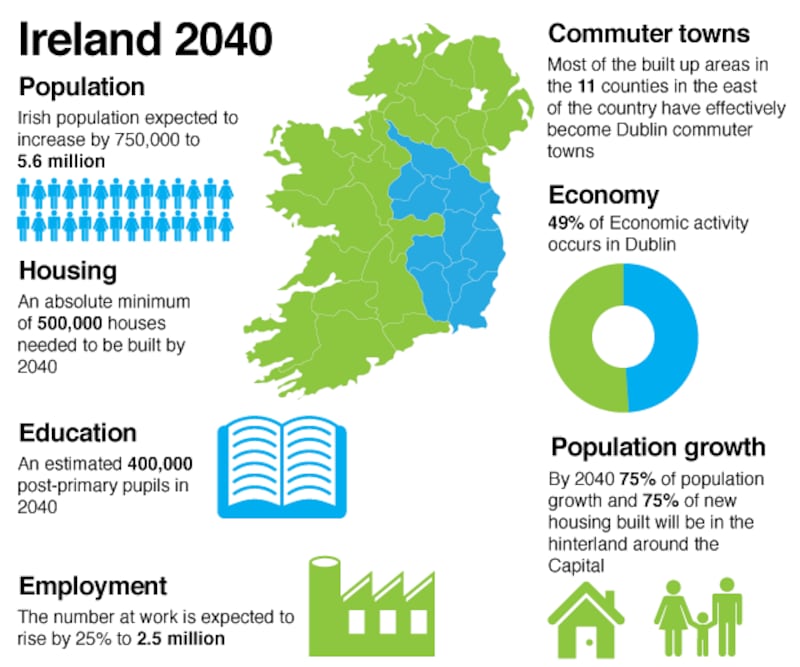Three-quarters of new homes and population growth over the next 25 years will be lopsided towards Dublin unless action is taken to spread development around the country, the Government will warn today.
It says Dublin will "potentially overheat", extending its sprawl into surrounding Leinster counties, and sucking up more resources and people unless a new planning framework is put in place.
Allowing current trends to continue means regional cities such as Cork, Limerick, Galway and Waterford "will grow, but not at the scale needed" to make up ground with Dublin. Instead the capital must develop in tandem with the rest of the country, but not ahead of it, according to Minister for Planning, Housing and Local Government Simon Coveney.

Taoiseach Enda Kenny and Mr Coveney will set out the first stages of the Government's spatial plan which seeks to map out Ireland's growth to 2040 at an event in Maynooth University on Thursday.
A consultation period will be opened, and a number of drafts of the plan will be published before a final version is put to a Dáil vote by the end of the year.
Fianna Fáil have already criticised the broad outline of Mr Coveney's approach because it claims it neglects the northwest of the country.
Mr Coveney says the population of the country will increase by around one million by 2040. Over a fifth of the population will be over 65, an extra 500,000 people will be at work, and a further 500,000 homes will be needed
Extra population
The initial document warns that “around three-quarters of the extra population and homes will happen on the eastern side of the country, much of it clustered around, but not necessarily happening in, our capital city”.
“This will further exacerbate massive and increasingly unmanageable sprawl of housing areas, scattered employment and car-based commuting, presenting major challenges around lopsided development, under-utilised potential, congestion and adverse impacts on people’s lives and the environment,” it says.
It also says smaller rural towns and villages outside the “orbit” of major towns and cities and tourism hot spots like the Wild Atlantic Way “will increasingly stagnate and decline”.
The plan, titled Ireland 2040, follows the previous national spatial strategy which was intended to cover the period from 2002-2020. It identified nine so-called "gateway" towns and cities, and nine "hub towns".
Mr Coveney has criticised this as a “one-for-all” approach, and his department said it was a “mixed bag” which was never fully implemented.
Regional cities
He previously indicated that a handful of regional cities were to be earmarked for expansion over the next 25 years as a way to balance economic and social growth. Cork, Waterford, Limerick and Galway, as well as a potential new city in the midlands, would see greater population growth, more jobs and increased investment in transport links.
An initial draft will be published around Easter, with another following by the summer. The final plan will be completed by the end of the year.
Speaking on Newstalk in advance of the launch, Mr Coveney said the spatial strategy would not be “a political trick to try to be popular”, as the decentralisation project had been.
“If you take a populist political approach you will see a continuation of what happened in the last 20 years.”
Highlighting the need for changes, he said Waterford had better infrastructure to cope with population growth than a commuter town like Navan. “These cities can be regional drivers.”
Mr Kenny said falling unemployment and an increasing population meant planning was needed to map out where to build houses, schools and roads.
“Now is the time to think about the longer-term future of all parts of this island and how to plan for that future. With the return of stability there are a number of projections and challenges that are likely to be realised that we need to start planning today.”








